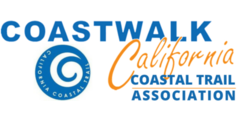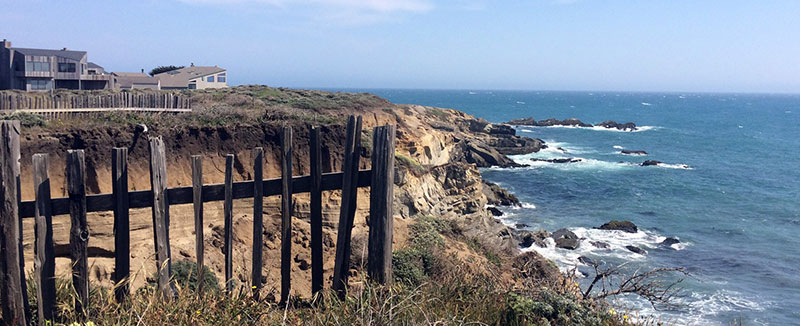Jun 6, 2020 Sonoma County Gazette
Share: https://www.sonomacountygazette.com/sonoma-county-news/the-sonoma-county-coastal-trail
The primary goal of the California Coastal Act, approved by voters in 1976, is ensuring and providing for public access to the state’s shoreline and ocean.
One of the dreams imbedded in that goal is the creation of a continuous trail along the coast from the Oregon border to Mexico, the California Coastal Trail.
It’s a breath-taking dream
The California Coastal Trail (CCT), when completed, will rival the famed Appalachian Trail in the eastern U.S. Roughly 1150 miles long, it would encompass 800 miles of coastline with twists and turns, swift rises with equally swift descents, braided together through beaches, bluffs, roadways, stairways and boardwalks. The CCT will provide a ribbon of protection for coastal access and preservation of coastal resources along the California Coast.

View from a section of the California Coastal Trail. Image: unofficialnetworks.com
The Coastal Act mandated that each coastal county and city, as part of developing their own Local Coastal Plan, include the planning and implementation of the California Coastal Trail through their jurisdictions.
Sonoma County has done so since the mid-1970’s, with considerable success. About two thirds of the county’s 65 miles of the California Coastal Trail has been completed, and planning for the remaining gaps is included in the current Draft Local Coastal Plan.
Enormous thanks are due to the local citizens’ groups, regional and state parks agencies, nonprofit organizations and public funding agencies, whose hard work has brought us this far.
One of the leading organizations in that effort was, and continues to be, Coastwalk/California Coastal Trail Association, the statewide advocacy group for the Coastal Trail, formed in 1980, and headquartered in Sebastopol.
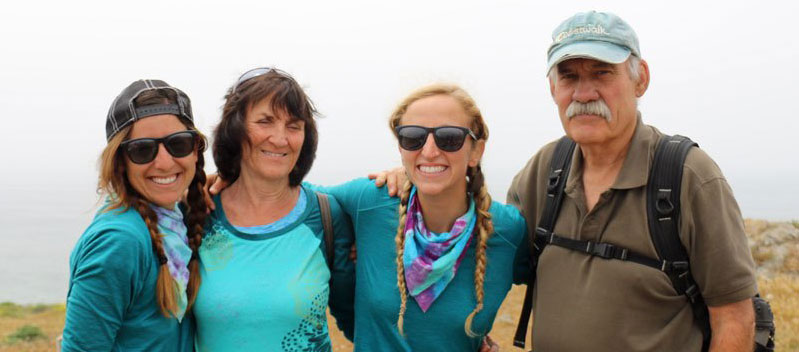
Morgan (Mo)(very left) and Joce (Jo) second from right, interns at the CA coastal trail association, embarked on an expedition from Oregon to Mexico on the California Coastal Trail in the summer of 2016. Richard Nichols, former Executive Director of Coastwalk California and one of the 1996 CCT thru-hikers and his wife Brenda (second from left) met up with them along the trail and shared their favorite memories of Coastwalk in its heyday and told Jo an Mo about the founder of Coastwalk, Bill Kortum, who was a coastal access activist and environmentalist. Image: coastwalk.org
Read more on the MoJo Coastwalk at https://coastwalk.org/?s=richard+nichols
Richard Nichols, a former Coastwalk Executive Director, and author of “Hiking the California Coastal Trail”, was instrumental in raising CCT awareness, securing planning funds, coordinating coastal county progress and yearly hikes, and two Coastal Trail thru-hikes from Oregon to Mexico.
Una Glass, a Sebastopol City Council member and former Coastwalk Executive Director, pushed and prodded Coastal Trail development through the lean years following the 2008 recession.

Cea Higgins, Executive Director of Coastwalk/California Coastal Trail Association congratulating honoree and co-founder Lucy Kortum May 2018- Image: www.facebook.com/coastwalk/
The current Coastwalk Executive Director, Cea Higgins, is a coastal resident and avid surfer. Cea is working to address impacts on the CCT such as sea level rise, and create opportunities for underrepresented communities to experience the CCT. Cea is also working to solve the current financial and social problems of Coastal Trail implementation.The 2020 Coastwalk Guided Hikes have been canceled due to the pandemic, which is impacting the financial well-being of the organization. Coastwalk continues to work with state, county and nonprofit organizations to support California Coastal Trail implementation.
You can join or donate to support the organization here: https://coastwalk.org/join-donate/
There are remaining gaps to completing the Coastal Trail in Sonoma County.
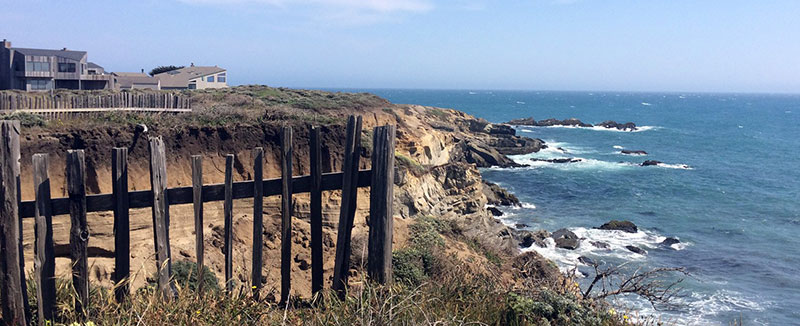
Blufftop homes along the Sea Ranch property. On the Sea Ranch property, the public trail dead ends at a “private trail,” which is only accessible to Sea Ranch homeowners and their guests. Today, you can walk through the full length of Sea Ranch if you are staying in the community. Image: coastwalk.org
Negotiations with Sea Ranch in the early 1980’s provided five neighborhood trails and beach access, a three-mile-long bluff top trail for public use, and a 120-acre donation to create Gualala Point Regional Park. Completion of the Coastal Trail would require a through trail 12 miles long (see map) from Gualala Point Regional Park south to connect with the proposed Kashia Coastal Preserve and Stewarts Point Ranch trails. Building this trail would require a considerable change in stance from Sea Ranch, where homeowners are wary of losing their privacy to hikers.
Click on map to view large zoomable and downloadable version. remaining gaps to completing the Coastal Trail in Sonoma County.
Another difficult area to implement is the seven-mile-long Highway 1 segment through Ocean Cove and Fort Ross ( see map). Highway 1, in places, is narrow and winding, and in numerous locations property owners have built into the highway right-of-way, complicating any planning process.A concerted planning effort was undertaken here, but natural and manmade complexities stalled the effort.
For the foreseeable future, Highway 1 will continue to be the Coastal Trail.
The management plan for the Jenner Headlands property (see map) includes a 2.5 mile segment of the Coastal Trail. Enhancement of the property has been underway by the Wildlands Conservancy for a decade. Public parking and restrooms and 15 miles of trails have recently been opened. When completed, the Jenner Headlands CCT segment will run from Russian Gulch to Jenner and connect with the Russian River Trail inland.

Jenner Headlands view. Image: Sonomacounty.com
South of the Russian River, the Carrington property (see map), soon to be added to the County Regional Park system, will provide two miles of Coastal Trail east of Highway 1 from Coleman Valley Road to Salmon Creek.
A Bodega Bay Trails Plan implementation has been ongoing for more than a decade, with Coastal Trail segments built both south and north of Bodega Bay such as the Coastal Prairie Trail.
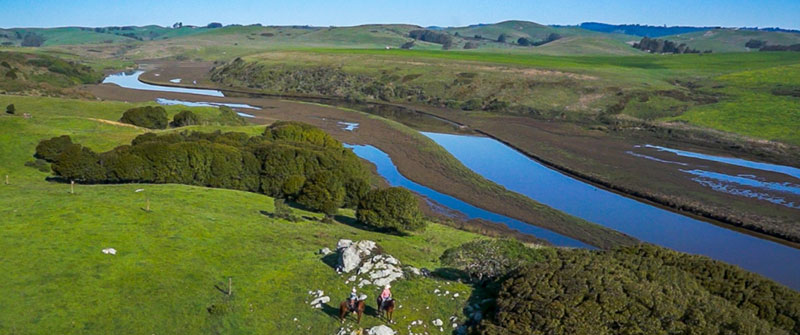
Estero Ranch is riparian to the Estero Americano which meanders through the northern boundary of the ranch for over two miles
The recent acquisition of the Estero Ranch (see map) and subsequent CCT implementation will connect with the southern boundary of Bodega Harbour and traverse to the county line at the Estero Americano. Currently, the Coastal Trail south from Bodega Bay is on Highway 1.
A most difficult gap remains: how to construct a trail through Bodega Bay that will be affordable and provide maximum public safety for all trail users. A vital entity in Coastal Trail maintenance and improvement is CalTrans, especially in difficult areas such as Bodega Bay and Ocean Cove-Fort Ross. They are an integral part of Coastal Trail implementation.
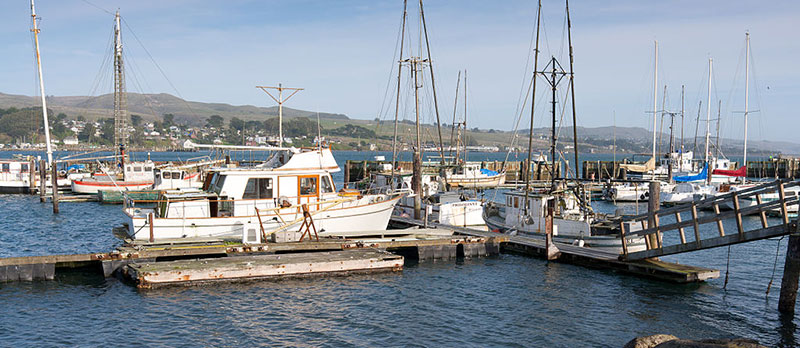
Fisherboats at Bodega Harbor. Image: Frank Schulenburg / CC BY-SA (https://creativecommons.org/licenses/by-sa/3.0)
The dream of a continuous coastal trail has been actively pursued by hundreds of people and organizations for nearly fifty years. In reality, much has been accomplished but much work remains. The future will require the continued hard work of dedicated public agencies, nonprofits and coastal trail enthusiasts.
